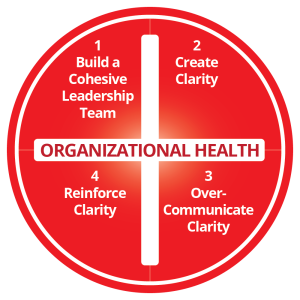Create Organizational Health
“For organizations to respond effectively to unexpected changes, failures, risks, and obstacles, they need to develop skills that give them agility, flexibility, and adaptability. This is what I call innovation muscles.”
-Maria Paula Oliveira, Innovation Leader, EY MENA
Preparation for the beginning of any journey is important. Before we could begin our strategic expedition, we needed to know we had the organizational health for this demanding work. So, in Phase 0, before strategic planning could begin, we looked carefully at our organization to promote overall organizational health.

We aligned UW-IT leadership for the collaboration, energy, and innovation we need to take on complex challenges. We looked carefully at the way we’re organized; we shed tasks that are no longer relevant, took on new responsibilities, and created a leaner organization that makes more sense to us—and our customers. The strong new governance system will lay out clearly to stakeholders how decisions are made and will guide decision-making consistently and strategically. We are now clear on why we exist and what each of us needs to do to amplify the success of the university.
The result of our work is a resilient and healthy organization committed to providing innovative and friendly business solutions. We are aligned on shared goals and a shared vision of what we need to become. Each of us is clear on the role of our units and how we function within them. We are healthy in the way that we challenge each other and hold each other accountable. As a healthy organization we are not afraid to innovate and think creatively—and even to be wrong from time to time.
Align Strategic Planning Leadership
In October 2023, we selected the strategic planning experts at Huron Consulting Group to help us analyze financial, technical, and human systems in information technology. Under their guidance we set up a process to ensure strong project leadership and engagement:
The Executive Committee will provide oversight for the project and provide direction and guidance on critical issues. Participate in strategic planning capability sessions. Champion the resulting strategic plan.
- Andreas Bohman, Executive Sponsor
- Alissa Mahar, Project Sponsor
The Steering Committee will provide feedback on analysis and deliverables, contribute ideas, and meet with Huron throughout to review project direction. They’ll lead the presentation of strategic plan to the UW community.
The Project Team will review analysis and deliverables, contribute content and ideas towards the new strategic plan, and meet with Huron regularly to review project deliverables. They also will lead presenting strategic plan to internal leadership.
- Alissa Mahar, Project Sponsor
- Piet Niederhausen, Project Manager
Establish the UW-IT Values
As a healthy organization, we live by core values guiding how we support the UW mission, do our work, and collaborate with one another.
Invested: Being invested means fully committing to the mission and goals of UW-IT and the University of Washington. We are motivated and engaged with our work and take ownership of our responsibilities, feeling a personal stake in UW-IT’s success. We take the initiative, are eager to learn and improve, and drive productivity and foster a positive work environment.
Compassionate: Compassion in the workplace is about recognizing humanity in our work and our impact on colleagues, partners, and customers. It is about being empathetic to the struggles of others, actively listening and offering support when needed, and creating a caring environment. As compassionate team members, we approach interactions with kindness and seek to understand diverse perspectives.
Team Players: As UW-IT team players, we collaborate effectively, communicate openly, and share knowledge, responsibilities, and recognitions. We understand that the best results are achieved when working together. We put the team’s goals ahead of our personal interests. We actively contribute to group efforts, help resolve conflicts, and work cohesively to achieve common objectives and foster a spirit of belonging and respect.
Create a Process for Flexible and Comprehensive Planning
In October we began the development of a detailed project plan and a timeline that can flex as the process does. We’re taking the time to do this right.
Identifying key inputs is critical to any strategic planning, including data about finance, services, systems, facilities, customers, and personnel. We targeted key data and information sources, including studies and surveys by Slalom, NIST and others. We asked Huron to examine agreements currently in place with external customers. Huron collected the University’s strategic plan as well as the Sustainable Academic Business Plan and UW-IT’s previous strategic plan. The “environmental scan” and deep dive into who we are amassed 100 files for analysis. In November, Huron was already deeply engaged in the analysis of our financial systems and had scheduled stakeholder discussions with over 300 administrators, faculty, staff, students, public policymakers, and university and corporate leaders.
All of these are needed to understand our “current state.”
